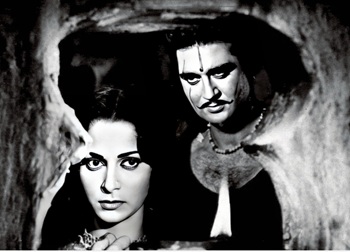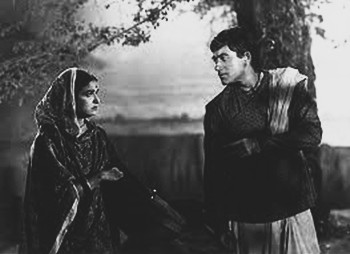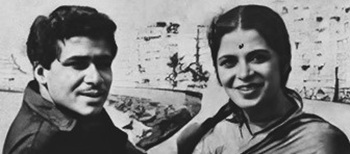Apr 15, 2025
Apr 15, 2025
The 1960s – The Golden Years – Part 7
By 1960 I had picked up enough Bengali to enjoy Bengali films. Apart from Pather Panchali and Kabuliwala, which I watched soon after arriving in Calcutta in 1957, I saw Satyajit Ray’s Aparajito, Jalsaghar, Apur Sansar, and Devi. Later I saw Debaki Bose's Sagar Sangamey which won the National Award for Best Bengali Film in 1959. In Rabindranath Tagore’s centenary year, 1961, I watched Satyajit Ray’s Teen Kanya and Tapan Sinha’s Kshudita Pashan, and in 1962, Satyajit Ray’s Kanchenjunga.
At the end of 1962, I was transferred to Asansol and in April 1965, I was deputed to the Trombay Unit of the Fertilizer Corporation of India, now known as Rashtriya Chemicals and Fertilizers (RCF), in Mumbai. Asansol had very few cinema halls, two of which were railway institutes (railway term for clubs). Durand Institute, which was the European Institute under the British was mostly populated by Anglo-Indians, who were still sizable in Indian Railways. Apart from holding weekly gatherings with ball dancing and Housie, also known as Bingo, Durand Institute exhibited English movies. The other Institute, known as Netaji Subhas Institute, was the Indian Institute of the old days. Its main activity was showing Indian, mostly Bengali, films. Our movie watching got more limited, both by my work restrictions and the availability of movies. I saw many of the movies released in this period later.
Films of 1963 and 1964
Bandini and Benazir were the last feature films produced by Bimal Roy, one of the top producers of the time, who was diagnosed with lung cancer. Sunil Dutt turned producer in 1963, producing three films under his Ajanta Arts banner, Yeh Rastey Hain Pyar Ke, Mujhe Jeene Do, and Yadein, which brought him a place amongst the producers of quality films. Chetan Anand produced Haqeeqat, a film on the 1962 war with China. Raj Kapoor produced his first colour film Sangam, with some of the sequences shot in Europe.
Noteworthy Films
Bandini – The last Classic from Bimal Roy
 Based on a Bengali novel titled Tamasi by Jarasandha, the nom-de-plume of Charu Chandra Chakrabarti, a former jail superintendent, it starred Ashok Kumar, Nutan, and Dharmendra. Set in the 1930s, the film tells the story of a young woman undergoing a sentence for a murder she commits in a fit of passion. The very kind and understanding young and handsome jail doctor shows interest in her but she rejects him because she cannot give him anything more than the burdens of her past. The jailer, who treats Kalyani like his daughter wants her to marry the doctor and she tells him her story. Kalyani, the daughter of a village postmaster, is attracted to a revolutionary (Bikash) with infectious laughter, who is under house arrest near the village and visits her father occasionally, to hear the former recite Vaishnavite verses. On one occasion, with her father away, he turns up with a high fever and Kalyani hides him in her room and tends to him. The villagers, accuse her of losing her honour, causing immense distress to her father. They are mollified only when Bikash promises to marry her on his return. But he fails to return, and Kalyani leaves the village to avoid her father being persecuted further. She finds a job as a nurse to a hysterical woman who, Kalyani discovers, is Bikash’s wife. In a fit of depression and rage, she poisons the woman and lands up in jail.
Based on a Bengali novel titled Tamasi by Jarasandha, the nom-de-plume of Charu Chandra Chakrabarti, a former jail superintendent, it starred Ashok Kumar, Nutan, and Dharmendra. Set in the 1930s, the film tells the story of a young woman undergoing a sentence for a murder she commits in a fit of passion. The very kind and understanding young and handsome jail doctor shows interest in her but she rejects him because she cannot give him anything more than the burdens of her past. The jailer, who treats Kalyani like his daughter wants her to marry the doctor and she tells him her story. Kalyani, the daughter of a village postmaster, is attracted to a revolutionary (Bikash) with infectious laughter, who is under house arrest near the village and visits her father occasionally, to hear the former recite Vaishnavite verses. On one occasion, with her father away, he turns up with a high fever and Kalyani hides him in her room and tends to him. The villagers, accuse her of losing her honour, causing immense distress to her father. They are mollified only when Bikash promises to marry her on his return. But he fails to return, and Kalyani leaves the village to avoid her father being persecuted further. She finds a job as a nurse to a hysterical woman who, Kalyani discovers, is Bikash’s wife. In a fit of depression and rage, she poisons the woman and lands up in jail.
Moved by Kalyani’s story, the jailer persuades her to marry the doctor who is still waiting for her. When Kalyani gets an early reprieve for good behaviour, the jailer sends her to the doctor’s town. The train arrives at a junction on the banks of the Ganga, where people cross the river in a steamer, a sequence shot in Sahibganj Ghat on the Eastern Railway. While waiting for her train, Kalyani meets Bikash, now a TB patient, on his way to his native village across the river. From his escort, she learns that at the insistence of his party, Bikash had sacrificed his deep love to marry a relation of a top police officer, to help the party collect intelligence. Bikash begs her pardon and leaves for the steamer. When her train is about to start, Kalyani hears the siren of the steamer and suddenly gets off the moving train, runs to Bikash, and falls at his feet, choosing her old love instead of the promise of her new admirer.
Ashok Kumar hesitated to accept the role of Bikash because he was unhappy about the hero’s betrayal and agreed only after hearing stories about the sacrifices of the revolutionaries. Bimal Roy had told him that “there is no one else who can laugh heartily like you in the role of Bikash.” Nutan had just married Lieutenant-Commander Rajnish Bahl, son of PC Bahl, General Manager of Indian Railways when Bimal Roy offered her Kalyani’s role in Bandini. When she told him that she was contemplating giving up films altogether, Bimal Roy said that in that case, he wouldn’t be able to make this picture. Rajnish persuaded Nutan to accept the role and continue her career. Nutan conceived during the filming of Bandini. Bimal Roy promised to finish shooting long before the baby was due. Nutan did not look like an expectant mother even in her ninth month. Dharmendra was the winner of a nationwide new talent award organized by Filmfare in 1960. Bimal Roy offered him the role of the prison doctor in Bandini. Since the film was delayed, Dharmendra’s other films, starting from Dil Bhi Tera Hum Bhi Tere (1960), were released earlier.
Brilliant direction and excellent performances by Ashok Kumar, Nutan, Dharmendra, and Tarun Bose with S.D. Burman’s soul-stirring melodies, made Bandini a classic. Bimal Roy was at his best. When Kalyani joins the hospital to work as a maid, viewers are intrigued by the noises of construction in the neighbourhood. The same noises are used to convey her feverish state of mind, with the light, and shades from the sparking of the welding machine reflecting from Kalyani’s face as she carries a cup of tea to her ward, with intermittent flashes of a poison bottle.
Gulzar made his debut as a lyricist with Mera gora anga laile. Gulzar was working with Bimal Roy as an Assistant Director when SD Burman was upset with Shailendra who had written all the songs of Bandini. Bimal Roy advised Gulzar to go to SD Burman to work on the songs for Bandini. The last song, based on a Vaishnavite verse, was written by Gulzar. Bimal Roy wanted to film it indoors, but SD Burman differed. In his opinion, it would be embarrassing for a girl to sing a love song before her father. Bimal Roy eventually agreed. Mera gora anga laile is exquisitely picturised.
Lata Mangeshkar’s solos, Mera gora ang lai le and Jogi jabse tu aaya, Asha Bhonsle’s solos Ab ke baras bhej and O panchhi pyare, Mukesh’s O janewale ho sake and SD Burman’s O mere majhi are all gems. Lata Mangeshkar sang for SD Burman after a gap of five years. During the making of Sitaron Se Aage (1957), SD Burman was not satisfied with Pag thumak chalat balkhaye and wanted to record it again, but Lata Mangeshkar was busy and could not find time for the recording. SD Burman used Asha Bhonsle to sing it but she too could not render the song the way SD Burman wanted. So, finally, the original Lata version was retained for the film. But SD Burman was hurt, and he replaced Lata Mangeshkar with Asha Bhonsle in all his subsequent films. The ice was broken when RD Burman became a full-fledged music director in Chhote Nawab and composed the melodious, classical-based song Ghar aaja ghir aaye for the film. When SD Burman heard the tune, he called Lata Mangeshkar and asked her to sing it, bringing her back into the Burman fold.
Bandini won the Award for Best Feature Film in Hindi in the 11th National Film Awards in 1963 and, in the same year, the film won Filmfare Awards for Best Film, Best Direction, Best Actress, Best Story, Best Cinematography and Best Sound Recording.
 Mujhe Jeene Do was the third successful film on dacoits released within four years, revealing public interest in the subject. Unlike Raj Kapoor’s Jis Desh Mein Ganga Behti Hai and Dilip Kumar’s Ganga Jamna, Sunil Dutt’s Mujhe Jeene Do was shot in the Chambal Valley ravines in Madhya Pradesh. The film, starring Sunil Dutt and Waheeda Rehman, was directed by Moni Bhattacharjee and had music by Jaidev.
Mujhe Jeene Do was the third successful film on dacoits released within four years, revealing public interest in the subject. Unlike Raj Kapoor’s Jis Desh Mein Ganga Behti Hai and Dilip Kumar’s Ganga Jamna, Sunil Dutt’s Mujhe Jeene Do was shot in the Chambal Valley ravines in Madhya Pradesh. The film, starring Sunil Dutt and Waheeda Rehman, was directed by Moni Bhattacharjee and had music by Jaidev.
The film was an authentic portrayal of the lives of dacoits. The unit of Sunil Dutt’s Ajanta Arts shot in actual bandit territory in the Bhind-Morena ravines in the Chambal valley, at some risk to their lives. They had to shoot under police protection. In Farooq Sheikh's TV show Jeena Isika Naam Hai, Waheeda Rehman described an incident when the police noticed some armed dacoits moving near the location where they were staying in tents. Sunil Dutt, “behaving like a dictator”, and the BSF Commander, hustled the film unit into jeeps to protect them. In real life, many dacoits had surrendered following a call by Vinoba Bhave and an amnesty agreement announced by the government.
The songs, written by Sahir Ludhianvi and composed by Jaidev, were brilliantly integrated into the narrative—such beautiful numbers as Raat bhi hai kuchh bheegi bheegi, Nadi naare na jao shyam, Maang meri bhar le rang, Tere bachpan ko jawani ki dua deti hoon. Sunil Dutt and Waheeda Rehman were outstanding in the film as were the actors in supporting parts. Mujhe Jeene Do was a hit and India’s official selection at the Cannes Film Festival that year. Although other dacoit films had been made before and after Mujhe Jeene Do, few were as powerful as this.
 Godaan, based on Munshi Premchand’s novel of the same name, is a poignant tale of a poor farmer who dreams of owning a cow but all his efforts come to naught as he tries in vain to struggle against the many forces ranged against him: the wealthy, the powerful, the greedy, even his kin, his son and his brother. Godaan is a story of how dreams can remain when all else is gone. It is a story of greed and avarice, of selfish ambition and love. As the farmer and his wife, Raaj Kumar and Kamini Kaushal live their roles. Trilok Jetley directs the film with feeling and Pandit Ravi Shankar’s music adds a feather in the cap of the film. Pipra ke patuwa sareekhe dole manuwa sung by Mohammed Rafi is one of my all-time favourites.
Godaan, based on Munshi Premchand’s novel of the same name, is a poignant tale of a poor farmer who dreams of owning a cow but all his efforts come to naught as he tries in vain to struggle against the many forces ranged against him: the wealthy, the powerful, the greedy, even his kin, his son and his brother. Godaan is a story of how dreams can remain when all else is gone. It is a story of greed and avarice, of selfish ambition and love. As the farmer and his wife, Raaj Kumar and Kamini Kaushal live their roles. Trilok Jetley directs the film with feeling and Pandit Ravi Shankar’s music adds a feather in the cap of the film. Pipra ke patuwa sareekhe dole manuwa sung by Mohammed Rafi is one of my all-time favourites.
Shahar Aur Sapna produced and directed by KA Abbas is about a young couple searching in vain for a home of their own in a metropolis, amidst the backdrop of a rapidly developing city. The euphoria of the first decade after independence reflected in films of hope and anticipation in films of the 1950s like Naya Daur, Insan Jaag Utha, and Boot Polish, had given way to bitterness and cynicism, as industrialization failed to solve the problems of the masses.
 The film was based on Abbas's own story One Thousand Nights on a Bed of Stones, which describes the struggle in the life of pavement dwellers against the backdrop of rapid industrialization. Shehar Aur Sapna is the story of an immigrant to Bombay who is unable to find shelter in the metropolis and is forced to move from place to place, while the government announces free housing for all pavement dwellers. In this process, he makes friends with different characters who try to help him. In his typical way, KA Abbas exposes the hollowness of political promises of progress and its effect on the deprived. In a telling denouement, the protagonist and his wife, finding the drainpipe that served as their temporary home lifted by a crane to be placed in position in the pipeline, enter another unused drainpipe and find themselves in a place that has a cradle for the child and a beautiful bed for the couple. The wife asks, Yeh kaun sa shehar hai? and her husband replies, Yeh shehar nahin, yeh sapna hai, emphasizing that, for the underprivileged, housing was still a dream.
The film was based on Abbas's own story One Thousand Nights on a Bed of Stones, which describes the struggle in the life of pavement dwellers against the backdrop of rapid industrialization. Shehar Aur Sapna is the story of an immigrant to Bombay who is unable to find shelter in the metropolis and is forced to move from place to place, while the government announces free housing for all pavement dwellers. In this process, he makes friends with different characters who try to help him. In his typical way, KA Abbas exposes the hollowness of political promises of progress and its effect on the deprived. In a telling denouement, the protagonist and his wife, finding the drainpipe that served as their temporary home lifted by a crane to be placed in position in the pipeline, enter another unused drainpipe and find themselves in a place that has a cradle for the child and a beautiful bed for the couple. The wife asks, Yeh kaun sa shehar hai? and her husband replies, Yeh shehar nahin, yeh sapna hai, emphasizing that, for the underprivileged, housing was still a dream.
The main roles were played by newcomers Dilip Raj, son of veteran actor P Jairaj, and Surekha Patkar. David Abraham, Nana Palsikar, and Anwar Hussain played important characters. KA Abbas surveyed Bombay on foot to find authentic locations for the film. Most of the scenes were shot outdoors, in Mumbai slums and on roads, to recreate the life of the urban poor, complete with slums and huts by the railway line. For crucial scenes, the cylindrical drainpipes were carried to the studios. Produced on a shoestring budget, the film did not create a sensation at the box office but received critical acclaim, winning the 1964 National Film Award for Best Feature Film and the nomination for Filmfare Award for Best Film. Nana Palsikar won the Filmfare Award for Best Supporting Actor. Music Director JP Kaushik won Awards from the Uttar Pradesh Film Journalist's Association Lucknow and the Bengal Film Journalist's Association, Calcutta.
05-Apr-2025
More by : Ramarao Annavarapu

|
Another gripping narrative telling us of films of a bygone age. Heres an idea. From time to time, you may consider picking up one single film, and give us a detailed critical assessment of the plot, the apparent motives of the characters, the loopholes in the story, and various other things together with technical details of interest. Lets begin with Dev Anand's C.I.D. or even Taxi Driver !! |